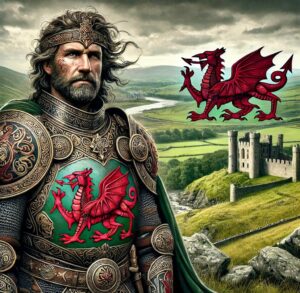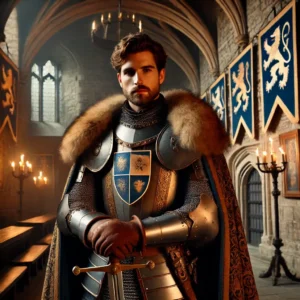Gwenllian ferch Gruffydd: The Warrior Princess of Wales
Gwenllian ferch Gruffydd Warrior Princess often referred to as the “Warrior Princess of Wales,” is a historical and symbolic figure in Welsh history. Born around 1097, she was the daughter of Gruffydd ap Cynan, King of Gwynedd, and Angharad ferch Owain. Through her lineage and actions, Gwenllian became a powerful representation of resistance and courage in medieval Wales.
Early Life and Legacy
Gwenllian grew up in the royal court of Gwynedd, a center of political strategy and cultural vibrancy in medieval Wales. Her father, Gruffydd ap Cynan, was a seasoned leader who had fought tirelessly to reclaim and consolidate his kingdom. She learned not only the skills of leadership but also strategies of military defense, skills that would later define her legacy.
Her marriage to Gruffydd ap Rhys, the prince of Deheubarth, was both a personal and political alliance. This union between the royal houses of Gwynedd and Deheubarth created a formidable partnership aimed at resisting Norman expansion into Wales. Together, Gwenllian and Gruffydd sought to restore and strengthen Welsh autonomy, becoming central figures in the ongoing struggle for independence.
Castles Associated with Gwenllian ferch Gruffydd Warrior Princess
- Kidwelly Castle: This iconic structure in Carmarthenshire is forever linked to Gwenllian’s legacy. It was near this castle that she led her famous rebellion against the Normans in 1136. Ghost Story: Gwenllian’s spirit is said to linger near the grounds where she fought her final battle. Legend tells of a spectral figure roaming the fields around Kidwelly Castle, her presence felt as a mournful reminder of her sacrifice. Visitors have reported eerie sounds of a battle and the faint cries of a woman at night, believed to be Gwenllian herself.
- Dinefwr Castle: As the stronghold of her husband Gruffydd ap Rhys, Dinefwr Castle was a key base for Gwenllian. Located in Llandeilo, this castle was a symbol of Welsh resistance and the power of the Deheubarth dynasty. Ghost Story: While less documented, local legends suggest that the spirits of Welsh warriors who defended Dinefwr Castle are said to appear on misty nights. Some visitors claim to see fleeting shadows along the castle walls, believed to be the restless guardians of its proud history.
The Battle of Maes Gwenllian (1136)
In 1136, while her husband Gruffydd was rallying support in Gwynedd, the Norman forces sought to capitalize on his absence. Gwenllian, unwilling to sit idly by, took up arms to defend her people. She rallied a force of local warriors and led them into battle against Maurice de Londres and his Norman troops near Kidwelly Castle. Her decision to lead the resistance herself was unprecedented for a woman of her time, reflecting her determination and leadership. The battle was fierce, with Gwenllian’s leadership inspiring her warriors to fight with relentless determination. However, the Normans ultimately overpowered her army. Gwenllian was captured during the conflict, and, in a brutal and symbolic act, she was executed by beheading. This rare and shocking act of violence against a noblewoman highlighted the threat she posed to the Norman occupiers.
The battlefield, known as Maes Gwenllian (“Gwenllian’s Field”), remains a poignant reminder of her sacrifice. Her death not only marked a tragic loss for the Welsh but also served as a rallying cry for further resistance. The Welsh resistance intensified in the aftermath, with many inspired by Gwenllian’s bravery and martyrdom.
A Skeptical Perspective
While Gwenllian’s story is celebrated in Welsh history, The exact scale of her involvement in military strategy or governance is debated, with some suggesting that her leadership may have been exaggerated to create a heroic narrative for a figure who symbolized resistance against oppression.
Additionally, the rarity of women in such prominent martial roles during her time raises. Questions about the extent of her actual battlefield presence. These questions remind us that while history celebrates her bravery. It is also shaped by the lenses through which it is told.
Legacy
Gwenllian’s death sparked outrage and further resistance among the Welsh. Her sons, including Rhys ap Gruffydd (later known as “The Lord Rhys”). Continued the fight against Norman rule, playing pivotal roles in the resurgence of Welsh independence. Her story resonates in the cultural memory of Wales.
Disclaimer
This blog aims to provide an overview of Gwenllian ferch Gruffydd’s life and legacy. Based on historical records, oral traditions, and modern interpretations. While every effort has been made to present accurate and balanced information. Some aspects of her story remain subject to debate and interpretation. Readers are encouraged to explore further sources and perspectives to gain a more comprehensive understanding of this fascinating historical figure.
Call to Action
If you enjoyed this exploration of Gwenllian ferch Gruffydd’s life and legacy. Visit my blog at brianwelsh500.com for more fascinating stories about Welsh history and castles. Don’t forget to subscribe for updates on new blog posts and share this article on your favorite social media platforms. To help others discover the rich history of Wales!
Sources:




